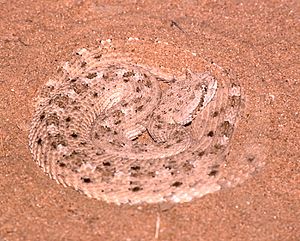Sonoran Desert sidewinder facts for kids
Quick facts for kids Crotalus cerastes cercobombus |
|
|---|---|
 |
|
| Scientific classification |
|
| Kingdom: | Animalia |
| Phylum: | Chordata |
| Class: | Reptilia |
| Order: | Squamata |
| Suborder: | Serpentes |
| Family: | Viperidae |
| Genus: | Crotalus |
| Species: | |
| Subspecies: |
C. c. cercobombus
|
| Trinomial name | |
| Crotalus cerastes cercobombus Savage & Cliff, 1953
|
|
| Synonyms | |
|
|
Common names: Sonoran Desert sidewinder, Sonoran sidewinder. The Sonoran Desert sidewinder (Crotalus cerastes cercobombus) is a venomous pitviper that lives in the Sonoran Desert. This desert covers parts of the southwestern United States and northwestern Mexico. Its scientific name, cercobombus, means buzzertail, which is a cool name for a snake!
What Does This Sidewinder Look Like?
This special type of sidewinder has a few unique features. Adult snakes have a black part near their rattle. This helps tell them apart from other sidewinders.
They also have different numbers of scales on their bodies:
- Scales on their belly (called ventral scales) range from 132 to 144 in males and 138 to 148 in females.
- Scales under their tail (called subcaudal scales) are usually 18 to 24 in males and 14 to 19 in females.
- They typically have fewer than 21 rows of scales around the middle of their body.
Where Does This Snake Live?
The Sonoran Desert sidewinder is found in the United States and Mexico. In the United States, you can find it in Arizona, specifically in Yuma, Maricopa, Pima, and Pinal counties.
It also lives southward into Sonora, Mexico. The first place this snake was officially found and described was near Gila Bend, Maricopa County, Arizona.
Scientists Campbell and Lamar (in 2004) described its home as the desert areas of south-central Arizona and parts of western Sonora. This includes Tiburon Island in the Gulf of Mexico.
How Scientists Name This Snake
This specific type of sidewinder, called a subspecies, was first described by scientists J.M. Savage and F.S. Cliff in 1953. They used information from other researchers like Stanford, Klauber, and Hensley.
They named this new form C. c. cercobombus. They noted that it lived in the eastern part of the area where another sidewinder subspecies, C. c. laterorepens, was found.

